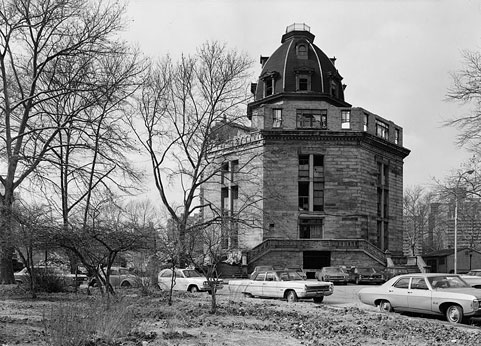This city has been my home for five of the last six years and I am two days away from the flight that will take me out of it indefinitely. It seems like a good moment to explore parts of the city that I never got to before. A friend has just become licensed as a city tour guide and is piloting his tour of Yorkville. It's a secluded and often overlooked neighbourhood. I join him for a stroll through the drizzle, past Gracie mansion and the apartment building that once housed the Nazi party of America. At the start of the tour a building across the East River catches my eye.
Toward the northern end of Roosevelt Island stands a striking little segment of asylum architecture: The Octagon.

The Octagon is now the entrance to a well appointed apartment building, but it used to be the centrepiece of the New York City Lunatic Asylum. According to my tour guide friend wealthy people in need of psychiatric care were more likely to end up at the West Side's long-gone Bloomingdale Asylum. The last remaining building from that institution -- Buell Hall -- now sits incongrously on Columbia university's Morningside campus housing several academic departments. New York City Lunatic Asylum was state run, and this was the place that you got incarcerated if you were poor and insane in New York.

Long before David Rosenhan sent his students off to pose as psychiatric patients, the pioneering journalist Elizabeth Seaman (an amazing character in her own right -- I strongly recommend the linked page) went undercover at the asylum to expose conditions. She gained admittance by feigning a pervasive and global amnesia, causing a mini media sensation in the process with her youth and striking looks. The book she wrote (Ten Days in a Madhouse, written under the non de plume Nellie Bly) detailed sadism by asylum staff, disgustingly unsanitary conditions, and inedible food. At one point Seaman found a spider baked into her bread. The book's publication led directly to an increase in funds to the asylum and became part of a much broader movement in which the working practices of insane asylums were exposed and reformed.

Benign neglect: The Octagon in 1970
The asylum was closed at the beginning of the 20th Century and the buildings taken over by the Metropolitan Hospital. The latter moved off Roosevelt Island in 1955, and the building fell into the kind of neglect that was widespread in parts of New York right through the 1950s, 60s and 70s. This still seems so astonishing in the contemporary New York of unceasing development and barely affordable rent. In 1972 (two years after the photo above) the last remaining part of the building -- the Octagon -- was put on the natonal register of historic places.
It's a cold and drizzly day when I take the elevated tramway over to Roosevelt. This island has always felt ahistorical to me. It's a warren of newly built apartment buildings with a Starbucks and a Duane Reade. Unless you have access to the gyms or swimming pools dotted around, or want to look at Manhattan from an unusual perspective, there are few reasons to visit.
You have to walk through all that to get to the Octagon complex. Moving north you start to pass tennis courts and coniferous trees. The whole place has the air of a country retreat, and feels about as far away from New York as it is possible to be while still technically within the borough of Manhattan.
I walk in past the concierge and am immediately confronted by the smartly renovated spiral staircase. This takes you up past a billiard room, a gym, and a play area for young children. Somewhere I have read that you aren't supposed to take photos, but no-one is around to care. All is serene. When I reach the top I feel like I could be in a lighthouse. Looking down the centre of the spiral staircase gives you a sense of space that few modern residential buildings manage to achieve.
You have to walk through all that to get to the Octagon complex. Moving north you start to pass tennis courts and coniferous trees. The whole place has the air of a country retreat, and feels about as far away from New York as it is possible to be while still technically within the borough of Manhattan.
I walk in past the concierge and am immediately confronted by the smartly renovated spiral staircase. This takes you up past a billiard room, a gym, and a play area for young children. Somewhere I have read that you aren't supposed to take photos, but no-one is around to care. All is serene. When I reach the top I feel like I could be in a lighthouse. Looking down the centre of the spiral staircase gives you a sense of space that few modern residential buildings manage to achieve.
It's fun to imagine that you are in some way communing with history in these buildings, and the Octagon shines a light on its own past. Prints of historical images from the building's asylum days are framed on the walls as you make your way up the stairs. Apart from these there is little to see. The refurbished interior is tasteful in its simplicity. As I leave I can see another of New York's island institutions from the northern tip of Roosevelt: the modernist concrete bulk of the Manhattan Psychiatric Center -- a state-run inpatient facility on Randall's Island -- looming out of the grey sky.
____________________________________________________________
More links:
Ten Days in a Madhouse full text here
Ten Days in a Madhouse as a free audiobook download.
This page at The Ruin has some good photos of the abandoned asylum buildings.
Asylum projects has a good page on the New York City asylum that skips some of the more lurid and sensationalist nonsense you find elsewhere.



No comments:
Post a Comment